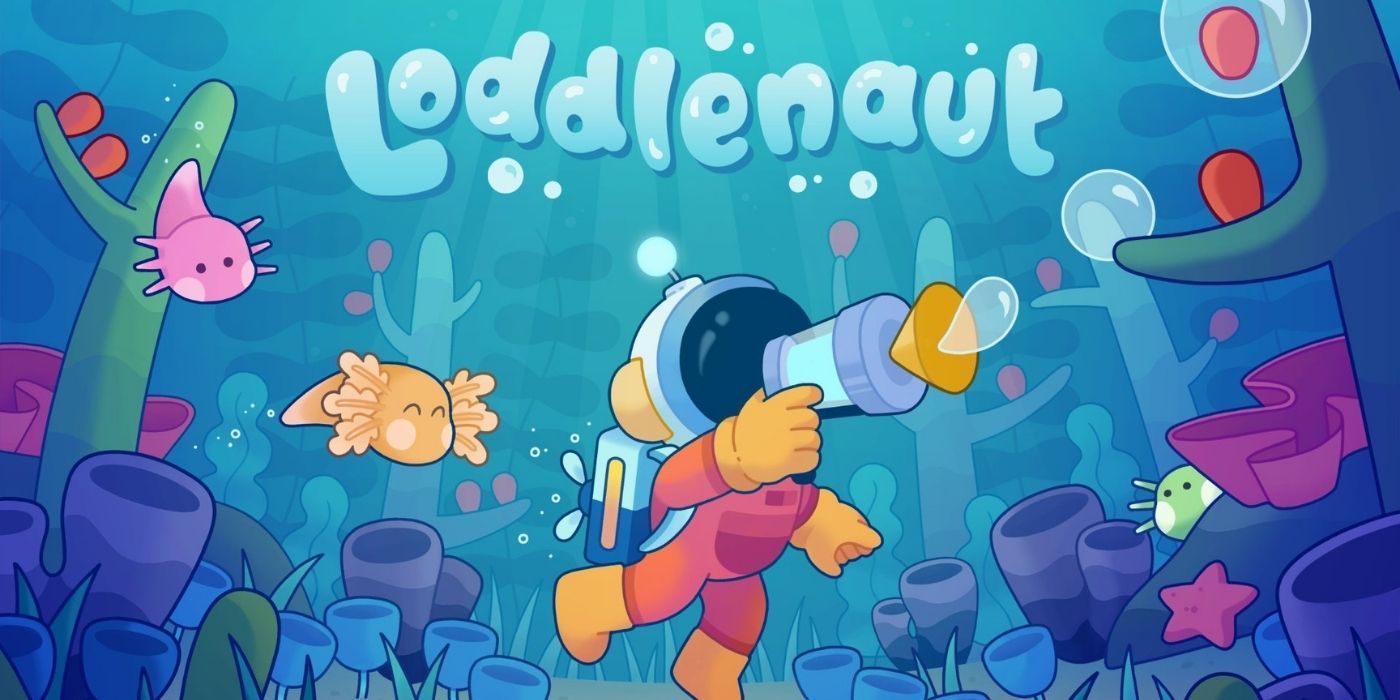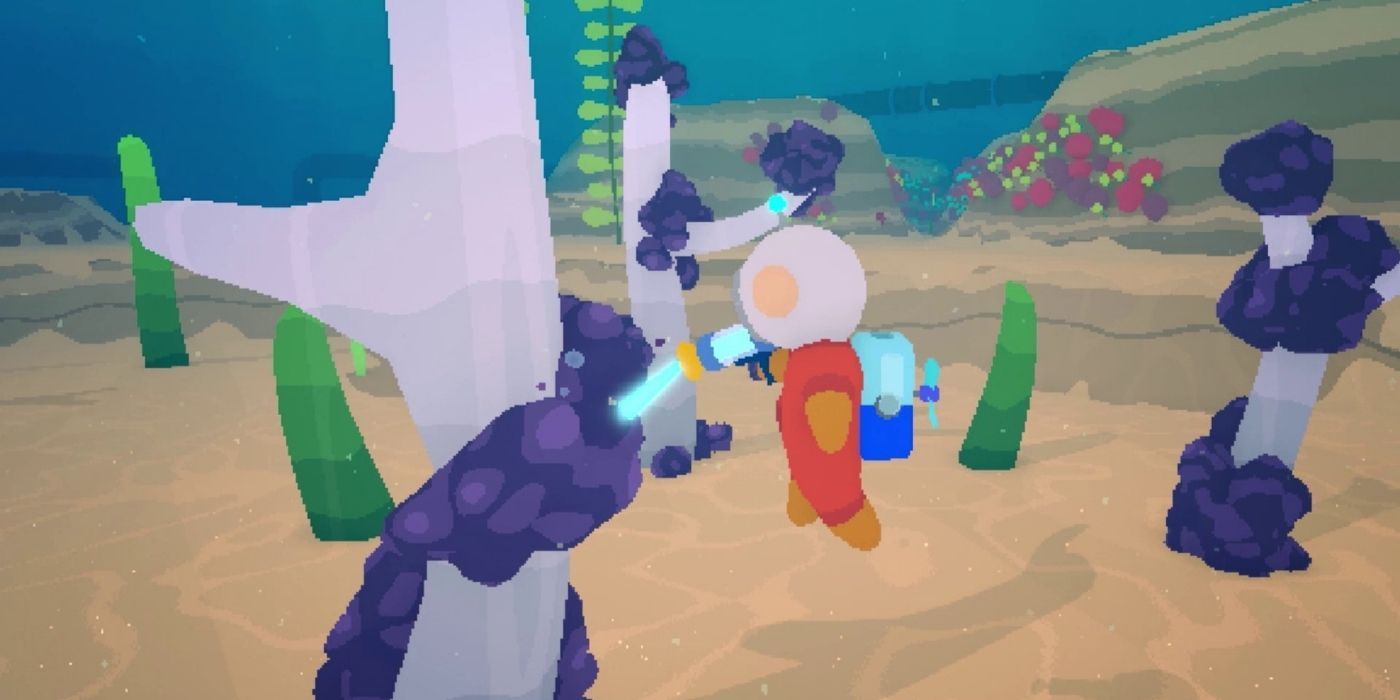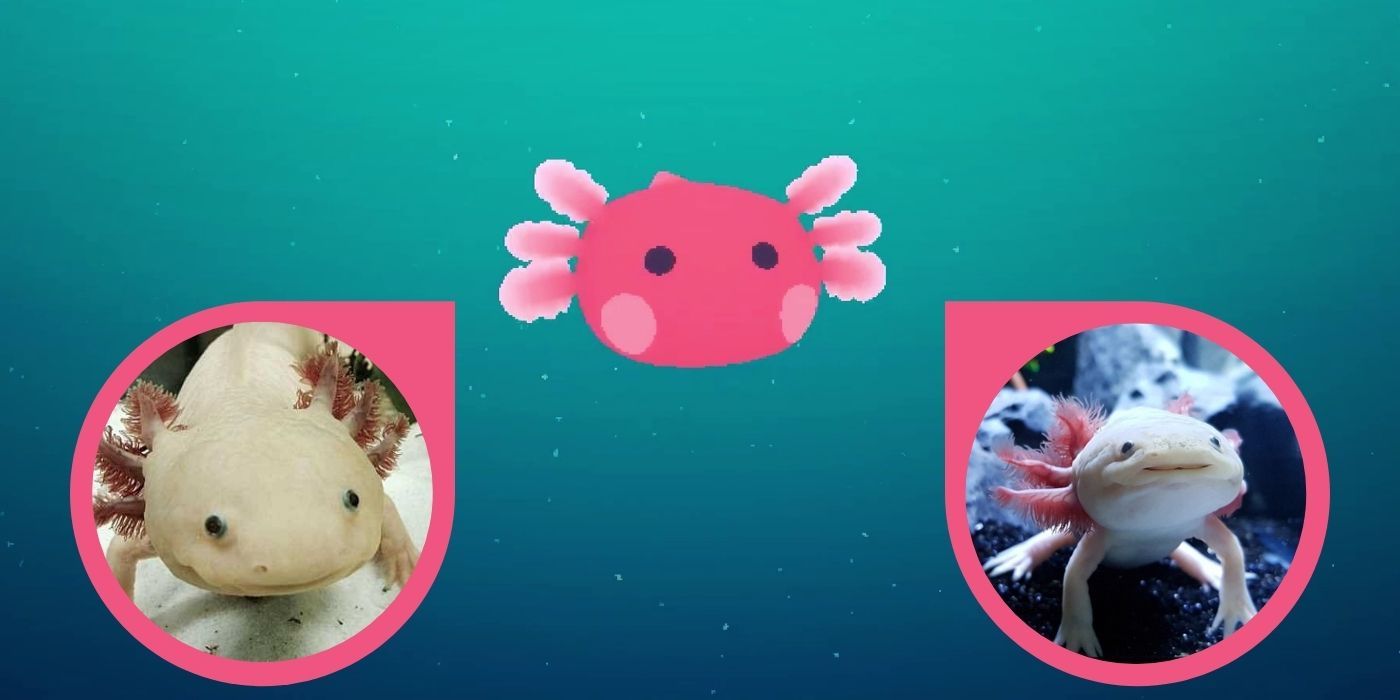Loddlenaut is a new indie game in development that combines the genres of pet-sim and survival games. Players take on the role of an interstellar custodian that is sent to the underwater alien planet of GUP-14, tasked with cleaning up the planet's oceans. During the player's oceanic adventures, they will come into contact with the planet's original inhabitants, the loddles. These cute axolotl-like creatures can be raised and befriended as part of the core Loddlenaut experience.
The studio behind Loddlenaut is Moon Lagoon, based out of Austin, Texas and comprised of two developers. Ricardo Escobar takes care of programming and tech art, and Jin-Young Sohn takes care of art, 3D modeling, and level design. In an interview with Game Rant, Escobar spoke all about the game's development journey, from its beginning as a student project to its successful Kickstarter campaign, the major themes about ocean conservation within Loddlenaut, and more. Interview has been edited for brevity and clarity.
Q: Congratulations on your successful Kickstarter campaign and reaching your goal!
A: Thank you. Yes, hopefully we can start unlocking some more stretch goals. We’re super excited about how excited everyone else is about our game. It’s been really nice to get all that support.
Q: Speaking about Kickstarter, it’s obviously where a lot of developers go to seek crowdfunding for their games. What made you decide on using Kickstarter for Loddlenaut, or did you consider any alternatives?
A: Back when we started this project as students at NYU, we had this class where different people from the industry would come in every week and they would do a little panel. One week, we had Anya Combs, the Director of Games Outreach at Kickstarter, come in and talk about how Kickstarter can be useful, how some people may think if you are going indie you need to have a publisher or have a really rich family, or you need to do Kickstarter. That class helped us realize that you can take any route you want.
You can do Kickstarter into a publisher, and some publishers require indie games to do Kickstarters. So we always wanted to work with a publisher to help make this game into a bigger thing. But we also realized early on that this game could really benefit from having a community behind it. We always wanted to work on a game where there’s a wiki on our game, that we didn’t make. Kickstarter, in addition to raising funds, it’s a really great way to build a community of really devoted people behind your game before releasing. So we reached out to Anya Combs at Kickstarter, and we've been talking with her since summer of last year, and we thought it would do okay on Kickstarter, being the type of game that it is.
Q: Loddlenaut was featured on last month’s Wholesome Direct. Do you think that helped drive people to your Kickstarter?
A: Yes, absolutely. One of our biggest decisions we had to make was whether we launch our Kickstarter the same day as the Wholesome Direct, or a few days after. We had been told the best day to launch a Kickstarter is always a Tuesday. Weekends are the absolute worst. Wholesome Games then said it would be on Saturday, at the beginning of E3. So we thought, do we wait and launch the Tuesday after? But that’s the same day as Nintendo’s big conference, we don’t want to compete with Breath of the Wild 2. We took the risk of launching on what would normally be a bad day for Kickstarter, banking on everyone just being super behind Wholesome Games. They were really kind to give us the one last spot at the end of the showcase. I think without that we wouldn’t be funded right now. Looking at our stats, a huge chunk of our funding came directly from the Wholesome Games website. We’re super indebted to them, and we’re glad we took the risk of launching at the same time as that showcase.
Q: Loddlenaut started as a thesis project. Looking back on where you started with the game to where you are now, how does that feel?
A: It feels very strange. Along the way, it felt very strange, because we’re still just two people making this game in this room, and we’re seeing all these people that we’ve never met being excited to play our game on maybe the Nintendo Switch, or if it comes to Xbox. To us it still doesn’t feel like a real game, because we are just working on it ourselves. We started getting featured by Wholesome Games back when it was still a student project. We’re like "What is happening?" and we’re just trying to hit these student deadlines and make sure our professors approve of what we’re doing. In the meantime we started this [the Loddlenaut] Twitter account just to have fun and release in-progress GIFs.
That was crazy to see—our first real tweet back when we were students took off and was featured in all different Twitter accounts. Recently this week, we went back and booted up our original build of the game, and we tweeted about that. We didn’t realize just how gray everything looked back when we were students. I think along the way we thought "oh, this looks really nice," and then a month later we thought "oh, this looks really nice, too." Then a year later, "how do we think that even looked good?" It’s fun to see the progress, for sure.
Q: Players are custodians sent to the alien planet GUP-14. As they explore, players will learn more about GUPPI, a mega-corporation that used to be on the planet. How has Moon Lagoon intertwined that into the main gameplay elements?
A: The main way we plan to deliver that backstory is through finding diary entries, holographic diary entries that are left throughout the ocean. Those will be written by employees of GUPPI. It will give a bit of the sinister backstory of what GUPPI might have been doing there, but from an employee’s perspective. Hopefully, a more human perspective. Like, "Hey I work here, but I don’t approve of what the execs are doing, but it’s a job, I have to pay rent." We’re hoping this way we can deliver the story of the traditional big bad corporation, while still telling a more human side of it, and how not everyone that was there is just this evil suit. There might be some evil suits that are in higher up positions, but you get a side of the humanity that was working there.
Q: There are several different biomes planned for GUP-14. How did Moon Lagoon go about differentiating each biome?
A: We started out by thinking how most video games might have a desert region and an arctic region, but we’re a bit limited because everything is underwater. The more we looked into it, we found there were certain areas in Earth’s ocean where it looks like it's snowing, or there could be these huge craters that are plateaus scattered everywhere. One of our most fleshed out environments right now is a place with a lot of these big crater with flat tops, and we based that on Ponyo after seeing a really nice scene with these grassy plateaus in the ocean. The more we looked into what can exist in Earth’s oceans—it’s already alien enough. The environment kind of makes itself at that point.
Q: Since Loddlenaut takes place entirely underwater, there are survival elements added to the game, such as the need to replenish oxygen and energy resources. What would happen if players don’t replenish these resources?
A: That’s been a difficult thing for us to balance. We don’t want it to be "oh, you ran out of oxygen and now you’re dead." Right now we’re leaning more towards the route of games like Stardew Valley, where if you run out of energy, you might black out and wake up back at your home base. The people you work for brought you back, but along the way you lost like half of your inventory. So if you want to get it back, you have to venture out to collect all those items again. It might be tricky to seek out all those items because they get scattered, and might sink to the ocean floor.
Q: Loddlenaut's takes inspiration from different games like Tamagotchi, Subnautica, ABZU, and Sonic Adventure 2. Are any of these the main source of inspiration?
A: Yes, definitely. The Chao Garden from Sonic Adventure 2. That was the original idea for the game, before we thought of anything else. We need to make a new version of the Chao Garden. It was so fun back in the day, and many people have been waiting for Sega to make an official spin-off. We thought, "why don’t we make this ourselves?" Then, what if it was all underwater, and you’re raising these little fish-like creatures. Then, the clean-up came after that. The initial idea was that we have to make an underwater Chao Garden game.
Q: Inspired by the Chao Garden, you created the loddles. Why are they based on axolotls?
A: Originally, we were thinking they would be all sorts of different creatures. Maybe a little turtle-type alien creature or a frog-type creature, but then there should definitely be an axolotl-type alien creature. They’re just really cute and they look kind of alien already. The more we looked into axolotls and their biology, they already kind of evolve. They look the way they do because they’re stuck in this child-like state, but if their surroundings change, they will go through a metamorphosis, turning into typical darker salamanders. If there’s already an animal that can do that, and they can regenerate limbs, why don’t we just base it entirely off of them?
Everyone loves axolotls. We can do a lot with having axolotls adapt based on their surroundings, based on their diet, growing in different ways. We also did a little bit of research, not just into axolotls, but into other similar salamanders. They tend to be very adaptable to a very specific biome. At Texas State University, there’s this specific type of salamanders that only lives in a lake at Texas State, and its adapted to only survive in those specific waters, and all of its traits are inherent to that specific location. The natural adaptability of salamanders lent itself well to having that Chao Garden mechanic where they grow depending on what you feed them.
Q: Will there be any other creatures to discover in GUP-14’s oceans, other than the loddles?
A: Yes. Originally we thought it would just be the loddles and the different forms that they evolve into, but if you’re bringing life back to an ocean, you want to see it really lush and lively. So, our plan is once you clean up different biomes, there will start to be—what we call—ambient critters that come in. You don’t necessarily get to raise them or interact with them in the same way you could do with the loddles, but they provide a feeling of life to an environment. It might be little alien eels that poke out of the rocks that you just cleaned up. It’s actually one of our reward tiers on our Kickstarter. We’re having our community help design those creatures with us.
Q: Previously, you’ve explained that players don’t actually own the loddles as pets, unlike other pet-sim style games. Is there an ecological message you want players to help players understand with this concept?
A: Part of that originated with what we wanted to change about the Chao Garden. I remember having fun with it as a kid, but looking back it was kind of weird with how you just raised the Chao to race each other or fight each other, and play around with them like toys. We went back to play Chao Garden, and if we jumped the wrong way, it would catapult the Chao off to the side, and it would get really sad.
We thought, if we were cleaning up this ocean and we’re trying to re-introduce these loddles back to their natural habitat, we want to have all the elements that make pet sims fun, but how could we do it in a way that they aren’t actually your pet. Also, it was partially inspired by when I was a kid, I would release Pokemon in like Pokemon Red or Blue, and the idea that maybe I’ll find that Charizard out in the wild, just doing its own thing. We want people to have that moment in Loddlenaut.
You’ve raised and helped bring this loddle back to life, and they’ve grown so much, and now it’s time to say goodbye. But they’re still out there doing their own thing, and you might come across them just living life out in the coral reef. Having a more complex relationship between players and their pets is something we wanted to explore.
Q: Players will be able to communicate with loddles by blinking their helmet lights. Can you explain how that Morse-code style of communication will work?
A: Right now, the way it works is that they will repeat whatever little sequence you send to them. It’s just like a basic form of acknowledging: "Hey, I understand that you’re trying to communicate with me." We’re hoping that the more you communicate with them, the more they’ll get to trust you. We’re not sure how we’ll be able to do this, but I want to make this work: If you send a certain message, and you do it enough times to a particular little, then that will get baked into their little memory. Then when you have that moment of releasing them into the wild and later on finding them, they’ll do that message back at you. Like, "Hey, I remember you. Here’s how we used to communicate." So just as a way of forming a very basic bond between the player and the loddles, and giving them some sort of memory about how they engaged with you.
Q: There is a clear message about ocean conservation in Loddlenaut. What might you hope players come to learn or understand about our own oceans that they might not already?
A: That was something we’ve been trying to strike a tricky balance between having a game that’s obviously themed with ideas of restoring oceans and sustainable practices, and just ocean conservation in general, without it being too heavy handed. People naturally tend to resist messages if they feel they’re being lectured or taught overtly. Our goal from the beginning was that we want to create a game that’s just fun, and it has clean-up mechanics because cleaning up is fun and satisfying to do.
Then maybe, someone plays the game and really enjoys it, then maybe they forget about it for a while, but then they go visit a local aquarium, and then they realize that "all of the things on this little plaque I’m reading [at the aquarium] about seaweed farming, this is the same thing I was doing in Loddlenaut, and I didn’t realize that it was something that could be done here on Earth." So reinforcing a more subconscious awareness of how we can reconsider our relationship to our own oceans, and what we can do to preserve them.
Q: There was a recent gas leak from an underwater pipeline in the Gulf of Mexico that caused the ocean to—quite literally—catch on fire. After seeing that, do you as developers have any new sense of urgency in developing Loddlenaut?
A: I can say that luckily with this extra attention we’ve been getting with the Wholesome Direct and the Kickstarter, we are starting to look into partnerships with organizations that promote ocean conservation. Things of that nature, I’m not allowed to reveal stuff quite yet. That is something, from the very beginning, we thought it would be so cool if this could branch out into collaborating with people who don’t normally work in the game space, or don’t normally have a voice by broadcasting their message through games.
As we’ve been working on this game, it feels like every month we turn on the news, and it’s something new related to how things are not looking great. We do feel more of a responsibility, more than just we’re making a game about cleaning up and it should be fun—now we want to make sure that we get the science right. Or at least accurate enough to where we’re not misrepresenting the work that is required to save our oceans, and just how dire things are, and how dire things could get.
Q: The past year has been tumultuous for almost everybody for multiple reasons. Has the pandemic affected development on Loddlenaut to any degree?
A: In some ways, we were lucky in that it’s just two of us working on the game, and we’ve lived together the whole time we’ve been working on it. So we didn’t have to go from working with each other in person constantly to suddenly having to figure out remote working. The flipside is that it’s hard to compartmentalize a project if you’re stuck in your room working on it constantly. It’s one thing to be super motivated to work on a game, but if you’re forced into one room and you can’t do anything other than what you can do inside, then it’s like "Well, if I can’t go outside, then maybe I’m wasting time if I’m not working on the game 24/7." So it’s been really hard for us to resist that urge.
I think we’ve managed it pretty well, but the lockdown started while we were still students and wrapping up the thesis side of this project. That was kind of a bummer, we were hoping to exhibit the game at a big end-of-year showcase. The biggest thing we haven’t had is people sitting in a chair, and watching them play the game. That was the biggest thing we lost, going into the pandemic, which every game developer has pretty much lost. Just seeing how people react when they pick up the controller, and move around for the first time. That’s something we’ve had to get around.
Q: As developers based in Austin, Texas, how did you fare during the winter storms earlier this year?
A: We got by pretty unscathed. We’re very lucky that we live on the same electrical grid as a hospital. So even though everyone’s power went out, ours did not, as they wanted to make sure that hospital stayed operating. We’ve been more affected with the Texas grid being more stressed out again, because of the heat. Every weekend or so we have the power go out. We actually had the power go out the day after we launched our Kickstarter, and we’re very lucky it didn’t go out the moment we hit the launch button.
Q: Loddlenaut is currently planned for a PC and Mac release. While you anticipate bringing it to the Nintendo Switch, is that confirmed or still in early stages?
A: Not confirmed, but it’s something we want to do everything we possibly can to make happen. We don’t want to confirm it until we basically have it in our hands and are playing it on the Switch. From the very beginning, we wanted to have the game on the Switch. So we’re trying to make that happen.
Q: Any plans for Loddlenaut to come to PlayStation or Xbox consoles as well?
A: We don’t have any reason to not want to be on those platforms, and we would love the game to be on as many platforms as possible, after the Switch being our priority. That’s part of the reason we started the Kickstarter, we’re only two people. Me, being the programmer, I have never made a console game before. So I want to do it, I just don’t know how, and everyone tells me it’s really hard. We’re not trying to promise it, but we’re keeping everything open, and making sure that everyone knows that we want it to be on the Switch as much as everyone else does.
Q: In regards to Loddlenaut’s PC and Steam release, many indie games like to launch in Early Access. Loddlenaut also has Alpha and Beta access as part of certain Kickstarter tiers. Do you anticipate launching in Early Access for Loddlenaut, or do you think you’ll get enough feedback in the Alpha and Beta?
A: It’s still something we’re going back and forth on. We’ve seen a lot of games with similar genres as us, use Early Access really well. The biggest of which being Subnautica and Slime Rancher. The Alpha and Beta could end up serving that purpose, but it’s always going to be, "where are we a year from now." Already from the Kickstarter, it’s been really great. Every day we get new suggestions for the game, or new ways we can change something we hadn’t thought of before. In that way, Early Access seems really great, but we don’t want to release an Early Access just because it’s unfinished. We want it to be an intentional way to bring the community more on board in helping us design the game.
Q: If you could tell one person who has never heard of Loddlenaut before one thing to get them invested in the game, what would that be?
A: Usually, it depends on the read I get from a person. Do they know games? Do they love axolotls? I think our go-to thing is: It’s a game that takes place entirely on an ocean planet, and your job is to clean up the entire ocean and raise these little alien creatures that grow in cool ways based on the foods they eat. That’s our concise elevator pitch.
[END]
Loddlenaut is in development for PC with an anticipated release in 2022.




